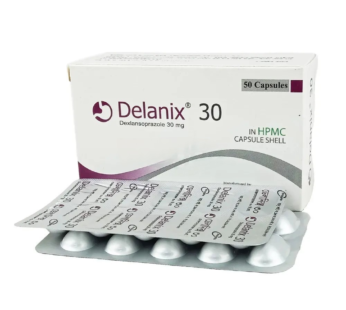Duloxen 30 mg
Description
Indications
Duloxen is a serotonin and norepinephrine reuptake inhibitor (SNRI) prescribed for the treatment of:
- Major Depressive Disorder (MDD)
- Generalized Anxiety Disorder (GAD)
- Diabetic Peripheral Neuropathic Pain (DPNP)
- Fibromyalgia
- Chronic Musculoskeletal Pain
Take the medicine as per the advice of a registered healthcare provider.
Pharmacology
Duloxetine Hydrochloride is an SSNRI intended for oral administration. It primarily inhibits the reuptake of serotonin and norepinephrine, with a relatively weaker effect on dopamine reuptake. Duloxetine does not have significant activity on dopaminergic, adrenergic, cholinergic, histaminergic, opioid, glutamate, or GABA receptors. It does not inhibit monoamine oxidase (MAO). After oral administration, Duloxetine is well absorbed, and its elimination occurs mainly through hepatic metabolism.
Dosage & Administration
-
Major Depressive Disorder (MDD):
- Starting Dose: 40 mg/day to 60 mg/day
- Target Dose: Acute: 40 mg/day (20 mg twice daily) to 60 mg/day (once daily or 30 mg twice daily); Maintenance: 60 mg/day
- Maximum Dose: 120 mg/day
-
Generalized Anxiety Disorder (GAD):
- Starting Dose: 60 mg/day
- Target Dose: 60 mg/day (once daily)
- Maximum Dose: 120 mg/day
-
Diabetic Peripheral Neuropathic Pain (DPNP):
- Starting Dose: 60 mg/day
- Target Dose: 60 mg/day (once daily)
- Maximum Dose: 60 mg/day
-
Fibromyalgia:
- Starting Dose: 30 mg/day
- Target Dose: 60 mg/day (once daily)
- Maximum Dose: 60 mg/day
-
Chronic Musculoskeletal Pain:
- Starting Dose: 30 mg/day
- Target Dose: 60 mg/day (once daily)
- Maximum Dose: 60 mg/day
Some patients may benefit from starting at 30 mg once daily. There is no evidence that doses exceeding 60 mg/day provide additional benefits, while some adverse reactions are dose-dependent. A gradual dose reduction is recommended to avoid withdrawal symptoms.
Take the medicine as per the advice of a registered healthcare provider.
Interactions
Duloxen is metabolized by both the CYP1A2 and CYP2D6 isozymes. When co-administered with fluvoxamine, a potent CYP1A2 inhibitor, the area under the curve (AUC), maximum concentration (Cmax), and half-life (t) of Duloxen are increased. Other drugs that inhibit CYP1A2 metabolism, such as cimetidine and certain quinolone antibiotics (e.g., ciprofloxacin, enoxacin), may produce similar effects, and their combination with Duloxen should be avoided. Additionally, the use of potent CYP2D6 inhibitors with Duloxen may result in higher drug concentrations.
Contraindications
Duloxen is contraindicated in patients with hypersensitivity to the drug or any of its inactive ingredients. It is not approved for treating bipolar depression. Duloxen should not be prescribed to patients with a history of significant alcohol consumption or chronic liver disease. In clinical studies, Duloxen has been linked to an increased risk of mydriasis, so caution is advised in patients with controlled narrow-angle glaucoma.
Side Effects
Common side effects include nausea, dizziness, dry mouth, constipation, loss of appetite, fatigue, drowsiness, increased sweating, hyperhidrosis, and weakness. Duloxen may slightly increase blood pressure. No significant differences in QT, PR, or QRS intervals were observed between Duloxen-treated and placebo-treated patients.
Pregnancy & Lactation
- Pregnancy: Category C. There are no adequate and well-controlled studies in pregnant women. Duloxen should only be used during pregnancy if the potential benefits justify the potential risks to the fetus.
- Labor and Delivery: The effects of Duloxen during labor and delivery in humans are unknown. Use only if the benefits outweigh the risks.
- Lactation: It is not known whether Duloxen or its metabolites are excreted into human milk. Therefore, breastfeeding while taking Duloxen is not recommended.
Precautions & Warnings
Patients being treated with antidepressants should be monitored for clinical worsening, suicidality, and unusual changes in behavior, especially during the initial phases of treatment or following dose adjustments. Blood pressure should be measured before starting treatment and periodically thereafter. Caution should be exercised when using Duloxen with NSAIDs, aspirin, or other drugs affecting coagulation, due to the risk of bleeding. It should be used cautiously in patients with a history of mania or seizure disorders.
Use in Special Populations
Safety and efficacy in pediatric patients have not been established.
Overdose Effects
There is limited clinical data on Duloxen overdose. There is no specific antidote, and treatment should involve general overdose management. This includes securing the airway, ensuring adequate oxygenation and ventilation, and monitoring cardiac rhythm and vital signs. Inducing vomiting is not recommended, but gastric lavage may be performed if done soon after ingestion or in symptomatic patients. Activated charcoal may help limit Duloxen absorption.
Therapeutic Class
Serotonin-norepinephrine reuptake inhibitor (SNRI)
Storage Conditions
Store at or below 30°C, away from light, and out of the reach of children.
Pack Image of Duloxen 30 mg Tablet










Reviews
There are no reviews yet.